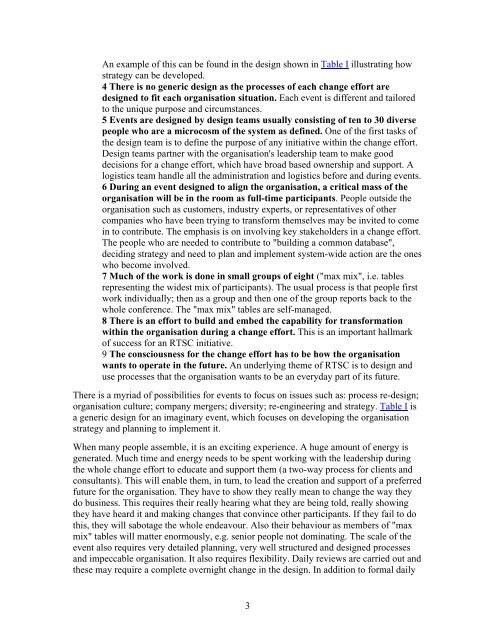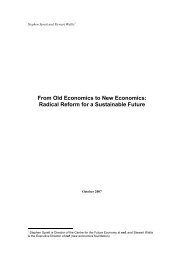Creating the futures we desire - getting the whole ... - Bruce Nixon
Creating the futures we desire - getting the whole ... - Bruce Nixon
Creating the futures we desire - getting the whole ... - Bruce Nixon
You also want an ePaper? Increase the reach of your titles
YUMPU automatically turns print PDFs into web optimized ePapers that Google loves.
An example of this can be found in <strong>the</strong> design shown in Table I illustrating how<br />
strategy can be developed.<br />
4 There is no generic design as <strong>the</strong> processes of each change effort are<br />
designed to fit each organisation situation. Each event is different and tailored<br />
to <strong>the</strong> unique purpose and circumstances.<br />
5 Events are designed by design teams usually consisting of ten to 30 diverse<br />
people who are a microcosm of <strong>the</strong> system as defined. One of <strong>the</strong> first tasks of<br />
<strong>the</strong> design team is to define <strong>the</strong> purpose of any initiative within <strong>the</strong> change effort.<br />
Design teams partner with <strong>the</strong> organisation's leadership team to make good<br />
decisions for a change effort, which have broad based ownership and support. A<br />
logistics team handle all <strong>the</strong> administration and logistics before and during events.<br />
6 During an event designed to align <strong>the</strong> organisation, a critical mass of <strong>the</strong><br />
organisation will be in <strong>the</strong> room as full-time participants. People outside <strong>the</strong><br />
organisation such as customers, industry experts, or representatives of o<strong>the</strong>r<br />
companies who have been trying to transform <strong>the</strong>mselves may be invited to come<br />
in to contribute. The emphasis is on involving key stakeholders in a change effort.<br />
The people who are needed to contribute to "building a common database",<br />
deciding strategy and need to plan and implement system-wide action are <strong>the</strong> ones<br />
who become involved.<br />
7 Much of <strong>the</strong> work is done in small groups of eight ("max mix", i.e. tables<br />
representing <strong>the</strong> widest mix of participants). The usual process is that people first<br />
work individually; <strong>the</strong>n as a group and <strong>the</strong>n one of <strong>the</strong> group reports back to <strong>the</strong><br />
<strong>whole</strong> conference. The "max mix" tables are self-managed.<br />
8 There is an effort to build and embed <strong>the</strong> capability for transformation<br />
within <strong>the</strong> organisation during a change effort. This is an important hallmark<br />
of success for an RTSC initiative.<br />
9 The consciousness for <strong>the</strong> change effort has to be how <strong>the</strong> organisation<br />
wants to operate in <strong>the</strong> future. An underlying <strong>the</strong>me of RTSC is to design and<br />
use processes that <strong>the</strong> organisation wants to be an everyday part of its future.<br />
There is a myriad of possibilities for events to focus on issues such as: process re-design;<br />
organisation culture; company mergers; diversity; re-engineering and strategy. Table I is<br />
a generic design for an imaginary event, which focuses on developing <strong>the</strong> organisation<br />
strategy and planning to implement it.<br />
When many people assemble, it is an exciting experience. A huge amount of energy is<br />
generated. Much time and energy needs to be spent working with <strong>the</strong> leadership during<br />
<strong>the</strong> <strong>whole</strong> change effort to educate and support <strong>the</strong>m (a two-way process for clients and<br />
consultants). This will enable <strong>the</strong>m, in turn, to lead <strong>the</strong> creation and support of a preferred<br />
future for <strong>the</strong> organisation. They have to show <strong>the</strong>y really mean to change <strong>the</strong> way <strong>the</strong>y<br />
do business. This requires <strong>the</strong>ir really hearing what <strong>the</strong>y are being told, really showing<br />
<strong>the</strong>y have heard it and making changes that convince o<strong>the</strong>r participants. If <strong>the</strong>y fail to do<br />
this, <strong>the</strong>y will sabotage <strong>the</strong> <strong>whole</strong> endeavour. Also <strong>the</strong>ir behaviour as members of "max<br />
mix" tables will matter enormously, e.g. senior people not dominating. The scale of <strong>the</strong><br />
event also requires very detailed planning, very <strong>we</strong>ll structured and designed processes<br />
and impeccable organisation. It also requires flexibility. Daily reviews are carried out and<br />
<strong>the</strong>se may require a complete overnight change in <strong>the</strong> design. In addition to formal daily<br />
3



